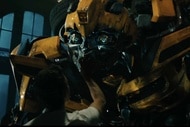The Swamp Thing costume and makeup are hot, sticky, and tools for self-love

Though the character's roots are solidly in the horror genre, DC's Swamp Thing has long been a metaphor for a much bigger world. Made up of humanoid-shaped vines and sludge and usually brought to life through great tragedy, Swamp Thing has often been implied to stand for external, environmental issues. In the latest live-action take from DC Universe, though, Swamp Thing is a creature whose greatest struggle is internal.
While DC Universe confirmed on June 6 that Swamp Thing wouldn't be coming back for a second season, the rest of the critically acclaimed Season 1 will still air as scheduled, taking viewers on a journey deep into the bayou.
The series follows Abby Arcane (Crystal Reed), who returns to a small town in Louisiana to investigate a mysterious, swamp-born virus. There she meets Alec Holland (Andy Bean), a disgraced scientist who quickly dies in the swamp — or so everyone thought. From that tragedy emerged a misunderstood monster with the ability to control the natural world around him: Holland's alter-ego, Swamp Thing, played by Derek Mears.
In an interview with SYFY WIRE ahead of the series' cancellation, Mears described his experience working on Swamp Thing as being an artist hunkered over a piece of paper, pen in hand, for seven months. Then, "the camera pulls out and the entire world is watching what you draw… I prefer to keep my relationship between the pen and pad. You guys tell me what you think because I'm just being me."
While Mears only plays one half of Swamp Thing's hero — with Bean portraying Alec Holland, the man at the creature's core — he's arguably shouldering the biggest load, both emotionally and physically. Underneath Swamp Thing's horror and supernatural elements is a deeply human story, a logline that inspires plenty of accurate comparisons to its titular character. Finding the emotion beneath the monster's mucky outer shell was vitally important to Mears and the show's creators, though it's a task easier said than done.
"You have to hit a pretty mellow, meditative state when going in because you have all of this makeup on for hours upon hours," Mears says. "Plus the emotional concept that you're dealing with for the character, the emotional complexity, which elevates your heart rate and you're basically lying to your body, but you're insulated with all this heat and swamp gunk, in a sense, and there's nowhere for that energy to go. So after say a highly emotional scene, you have to try to find a way to get oxygen and to level your heart rate out."
The news that Swamp Thing himself would rely mostly on practical effects rather than any sort of motion capture set the show's production apart from the beginning. Every day on set, Mears would don the enormous suit and spend hours in makeup — two hours to put on his face, one hour to get it off once they got it down pat. While a few slithering vines or moving leaves were added in post-production, everything you see onscreen is, for the most part, something Mears was actually wearing as he moved and emoted through it all.
It's physically taxing work, Mears says, but he is quick to add that he can't complain; whining on about the role's challenges would be akin to a lifeguard whining about having to get wet. This is exactly what he signed up for.
"It's that old adage of film," he muses. "That pain is temporary and film is forever. That's what you try to hold on to when creating a character like this."
To find that emotional core, Mears spent time studying DC Comics' various iterations of Swamp Thing and having long, winding talks with Bean about their duel performance.
"Essentially, the whole show is about acceptance," Mears explains. "The outside world is not accepting of [Swamp Thing], but essentially, [the audience] is inside the character accepting himself and once he accepts himself, the outer world accepts the inner world."
With that important message in mind, Mears wanted to create an homage to all the writers and artists over the years who have worked on Swamp Thing, as all those iterations mean different things to different people. Looking to creators Len Wein and Bernie Wrightson's original work on the character as well as takes from writer Alan Moore, artists Stephen Bissette and John Totleben, and many others, Mears would take note of their differing styles and ticks and then incorporate them into the role.
"As an actor, I'm putting my own spin on things," he says. "And after me, there's going to be comic books, there's going to be other movies and TV shows — I'm assuming because it's such an iconic character — for years to come. So my job, in a similar sense, is to put my stamp to that but also be respectful… acknowledge what [others] have done and what they've added to the mythos."
When Mears looks at the work he's done on Swamp Thing, he hopes the message of self-acceptance comes through more than anything else. Growing up in Bakersfield, California, Mears describes himself as the "different kid" because he has Alopecia, a disorder in which your hair falls out. This left Mears bald at an early age.
"And in Bakersfield, growing up, it wasn't cool to be white and bald," Mears says. Most of the time, people would mistake him for "a racist skinhead or a cancer victim." It made him feel like the outcast, and it wasn't until he moved to Los Angeles to pursue acting that he realized that what he'd thought all along was his greatest weakness was actually his greatest strength.
"With the Swamp Thing character, I hope people find that whatever makes them different — because we're all insecure about something or some sort of imperfection, physically or mentally in our own lives — that they can look to the character and go, 'Oh, I can relate to what he's going through. And he's okay with that,'" Mears says. "'I'm going to be okay, as well, and I'm going to embrace what makes me different and step on the gas pedal because that's who I am and I can't change that.'"



























